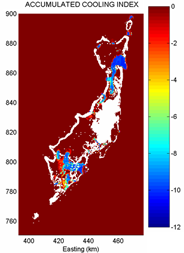Coral Reef Watch developed a pilot thermal stress model for coral reefs to identify areas which have a greater capacity for solar heating during bleaching weather conditions (i.e., low wind, low currents, clear sunny skies). The pilot project was undertaken in Palau.

A two-dimensional hydrodynamic model was used to simulate water movement around Palau. Model input included a bathymetric map of 250-meter resolution, derived from high-resolution satellite imagery; low-frequency currents; and high-frequency tidal currents. The model output was validated against in situ oceanographic data.

The output from the hydrodynamic model was combined with a modeled temperature vertical profile to determine the reduction in surface temperature due to mixing. The results were summarized into a measure of "thermal capacitance"-- i.e., the amount of solar radiation necessary to incur a specified surface-temperature increase for different locations. The resulting map is a tool that allows designers of marine protected areas and networks to incorporate resilience to potential future climate change.
This work was supported by:
The Nature Conservancy
The Australian Institute of Marine Science
NOAA's Coral Reef Conservation Program